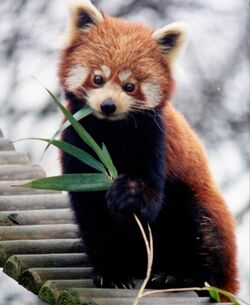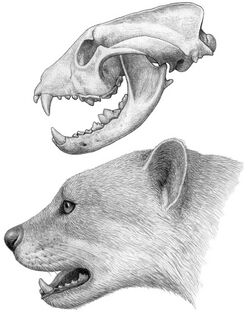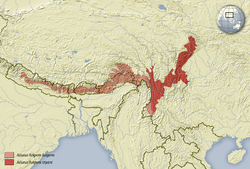Biology:Ailuridae
| Ailuridae | |
|---|---|

| |
| Red panda (Ailurus fulgens) | |

| |
| Skull and life restoration of Simocyon | |
| Scientific classification | |
| Domain: | Eukaryota |
| Kingdom: | Animalia |
| Phylum: | Chordata |
| Class: | Mammalia |
| Order: | Carnivora |
| Superfamily: | Musteloidea |
| Family: | Ailuridae Gray, 1843 |
| Subfamilies | |

| |
| Extant red panda distribution | |
Ailuridae is a family in the mammal order Carnivora. The family consists of the red panda (the sole living representative) and its extinct relatives.
Georges Cuvier first described Ailurus as belonging to the raccoon family in 1825; this classification has been controversial ever since.[1] It was classified in the raccoon family because of morphological similarities of the head, colored ringed tail, and other morphological and ecological characteristics. Somewhat later, it was assigned to the bear family.[2]
Molecular phylogenetic studies had shown that, as an ancient species in the order Carnivora, the red panda is relatively close to the American raccoon and may be either a monotypic family or a subfamily within the procyonid family.[1][3][4] An in-depth mitochondrial DNA population analysis study stated: "According to the fossil record, the Red Panda diverged from its common ancestor with bears about 40 million years ago."[1][5] With this divergence, by comparing the sequence difference between the red panda and the raccoon, the observed mutation rate for the red panda was calculated to be on the order of 109, which is apparently an underestimate compared with the average rate in mammals.[6] This underestimation is probably due to multiple recurrent mutations as the divergence between the red panda and the raccoon is extremely deep.[citation needed]
The most recent molecular-systematic DNA research places the red panda into its own independent family, Ailuridae. Ailuridae are, in turn, part of a trichotomy within the broad superfamily Musteloidea[7] that also includes the Procyonidae (raccoons) and a group that further subdivides into the Mephitidae (skunks) and Mustelidae (weasels); but it is not a bear (Ursidae).[8]
Ailurids appear to have originated during the Late Oligocene to Early Miocene in Europe. The earliest known member, Amphictis, was likely an unspecialised carnivore, based on its dentition. Ailurids subsequently dispersed into Asia and North America. The puma-sized Simocyon found in Middle Miocene-Early Pliocene of Europe, North America and China was likely a hypercarnivore. Like modern red panda it had a "false thumb" to aid in climbing. Members of the subfamily Ailurinae, which includes the modern red panda as well as the extinct genera Pristinailurus and Parailurus, developed a specialised dental morphology with blunted cusps, creating an effective grinding surface to process plant material.[9]
Classification
The relationship of the Ailuridae with other carnivorans is shown in the following phylogenetic tree, which is based on the molecular phylogenetic analysis of six genes in Flynn (2005),[10] with the musteloids updated following the multigene analysis of Law et al. (2018).[11]
| Carnivora |
| |||||||||||||||||||||||||||||||||||||||
In addition to Ailurus, the family Ailuridae includes seven extinct genera, most of which are assigned to three subfamilies: Amphictinae, Simocyoninae, and Ailurinae.[12][13][14][15][16]
- Family Ailuridae J.E. Gray, 1843
- Subfamily †Amphictinae ?Winge, 1896
- †Amphictis ?Pomel, 1853
- †Amphictis borbonica Viret, 1929
- †Amphictis ambigua (Gervais, 1872)
- †Amphictis milloquensis (Helbing, 1936)
- †Amphictis antiqua (de Blainville, 1842)
- †Amphictis schlosseri Heizmann & Morlo, 1994
- †Amphictis prolongata Morlo, 1996
- †Amphictis wintershofensis Roth, 1994
- †Amphictis cuspida Nagel, 2003
- †Amphictis timucua J.A. Baskin, 2017[17]
- †Amphictis ?Pomel, 1853
- Subfamily †Simocyoninae Dawkins, 1868
- †Actiocyon Stock, 1947
- †Actiocyon parverratis Smith et al., 2016[18]
- †Actiocyon leardi Stock, 1947
- †Alopecocyon Camp & Vanderhoof, 1940
- †Alopecocyon getti Mein, 1958
- †Alopecocyon goeriachensis (Toula, 1884)
- †Protursus Crusafont & Kurtén, 1976
- †Protursus simpsoni Crusafont & Kurtén, 1976
- †Simocyon Wagner, 1858
- †Simocyon primigenius (Roth & Wagner, 1854)
- †Simocyon diaphorus (Kaup, 1832)
- †Simocyon batalleri Viret, 1929
- †Simocyon hungaricus Kadic & Kretzoi, 1927
- †Actiocyon Stock, 1947
- Subfamily Ailurinae J.E. Gray, 1843
- †Magerictis Ginsburg et al., 1997
- †Magerictis imperialensis Ginsburg et al., 1997
- Tribe Pristinailurini Wallace & Lyon, 2022
- †Pristinailurus Wallace & Wang, 2004
- †Pristinailurus bristoli Wallace & Wang, 2004
- †Parailurus Schlosser, 1899
- †Parailurus anglicus (Dawkins, 1888) [Parailurus hungaricus Kormos, 1935]
- †Parailurus tedfordi Wallace & Lyon, 2022
- †Parailurus baikalicus Sotnikova, 2008
- †Pristinailurus Wallace & Wang, 2004
- Tribe Ailurini
- Ailurus F. Cuvier, 1825
- Ailurus fulgens - Red panda
- Ailurus fulgens styani Thomas, 1902 – Eastern red panda
- Ailurus fulgens fulgens F. Cuvier, 1825 – Western red panda
- Ailurus fulgens - Red panda
- Ailurus F. Cuvier, 1825
- †Magerictis Ginsburg et al., 1997
- Subfamily †Amphictinae ?Winge, 1896
An additional, unnamed taxon called only "Ailurinae indet." was described in 2001 based on an upper molar from Four, a Middle Miocene-age locality near Isère, France .[19]
References
- ↑ 1.0 1.1 1.2 "Uncertainty in Science: is the Giant panda a bear or a raccoon?". Nature 323 (6091): 769–771. 1986. doi:10.1038/323769a0. PMID 3774006. Bibcode: 1986Natur.323..769M.
- ↑ "Ailurus fulgens". Mammalian Species (American Society of Mammalogists) (222): 1–8. 1984. doi:10.2307/3503840.
- ↑ "Mitochondrial DNA sequence evolution in the Arctoidea". PNAS 90 (20): 9557–9561. 1993. doi:10.1073/pnas.90.20.9557. PMID 8415740. Bibcode: 1993PNAS...90.9557Z.
- ↑ "Molecular Phylogeny of the Red Panda (Ailurus fulgens)". J. Hered. 86 (6): 413–422. 1995. doi:10.1093/oxfordjournals.jhered.a111615. PMID 8568209.
- ↑ "Genetic Diversity and Population History of the Red Panda (Ailurus fulgens) as Inferred from Mitochondrial DNA Sequence Variations". Molecular Biology and Evolution 18 (6): 1070–1076. 2001. doi:10.1093/oxfordjournals.molbev.a003878. PMID 11371595.
- ↑ Molecular Evolution. Sinauer Associates. 2007. ISBN 978-0-87893-480-5.[page needed]
- ↑ Flynn et al., 2001[full citation needed]
- ↑ "Whence the Red Panda?". Molecular Phylogenetics and Evolution 17 (2): 190–99. 1 November 2000. doi:10.1006/mpev.2000.0819. ISSN 1055-7903. PMID 11083933. http://pandafriends.ru/wp-content/uploads/2011/01/Flynn2000.pdf. Retrieved 11 February 2018.
- ↑ Salesa, Manuel J.; Peigné, Stéphane; Antón, Mauricio; Morales, Jorge (2022), "Evolution of the family Ailuridae: origins and Old-World fossil record", Red Panda (Elsevier): pp. 15–29, doi:10.1016/b978-0-12-823753-3.00007-7, ISBN 9780128237533, http://dx.doi.org/10.1016/b978-0-12-823753-3.00007-7, retrieved 2022-06-29
- ↑ Flynn, J.J.; Finarelli, J.A.; Zehr, S.; Hsu, J.; Nedbal, M.A. (2005). "Molecular phylogeny of the Carnivora (Mammalia): Assessing the impact of increased sampling on resolving enigmatic relationships". Systematic Biology 54 (2): 317–337. doi:10.1080/10635150590923326. PMID 16012099.
- ↑ Law, Chris J.; Slater, Graham J.; Mehta, Rita S. (2018-01-01). "Lineage Diversity and Size Disparity in Musteloidea: Testing Patterns of Adaptive Radiation Using Molecular and Fossil-Based Methods" (in en). Systematic Biology 67 (1): 127–144. doi:10.1093/sysbio/syx047. ISSN 1063-5157. PMID 28472434.
- ↑ Classification of Mammals Above the Species Level. Columbia University Press. 1997. ISBN 9780231528535.[page needed]
- ↑ "Ailurid carnivoran mammal Simocyon from the late Miocene of Spain and the systematics of the genus". Acta Palaeontologica Polonica 50: 219–238. 2005. http://agro.icm.edu.pl/agro/element/bwmeta1.element.agro-article-8012e086-056a-483a-821e-01d84489ff00/c/app50-219.pdf.
- ↑ "Evidence of a false thumb in a fossil carnivore clarifies the evolution of pandas". Proceedings of the National Academy of Sciences 103 (2): 379–382. 2006. doi:10.1073/pnas.0504899102. PMID 16387860. Bibcode: 2006PNAS..103..379S.
- ↑ "Two new carnivores from an unusual late Tertiary forest biota in eastern North America". Nature 431 (7008): 556–559. 2004. doi:10.1038/nature02819. PMID 15457257. Bibcode: 2004Natur.431..556W. https://www.researchgate.net/publication/8258760.
- ↑ Goswami, Anjali; Friscia, Anthony, eds (2010). "Molecular and morphological evidence for Ailuridae and a review of its genera". Carnivoran Evolution: New Views on Phylogeny, Form, and Function. pp. 92–140. doi:10.1017/CBO9781139193436.005. ISBN 978-0-521-73586-5.
- ↑ "Additional carnivorans from the early Hemingfordian Miller Local Fauna, Florida". Journal of Vertebrate Paleontology 37 (2): e1293069. 2017. doi:10.1080/02724634.2017.1293069. Bibcode: 2017JVPal..37E3069B.
- ↑ "Middle Miocene carnivorans from the Monarch Mill Formation, Nevada". Acta Palaeontologica Polonica 61 (1): 231–252. 2016. doi:10.4202/app.00111.2014.
- ↑ Ginsburg, Leonard; Maridet, Olivier; Mein, Pierre (2001). "Un Ailurinae (Mammalia, Carnivora, Ailuridae) dans le Miocène moyen de Four (Isère, France)" (in French). Geodiversitas 23 (1): 81–85. https://www.researchgate.net/publication/237599256.
Further reading
- Davis D. Dwight (1964). "The Giant Panda: A Morphological Study of Evolutionary Mechanisms". Zoology Memoirs 3: 1–339.
- Decker D.M., Wozencraft W.C. (1991). "Phylogenetic Analysis of Recent Procyonid Genera". Journal of Mammalogy 72 (1): 42–55. doi:10.2307/1381979.
- Flynn, J.J. and G.D. Wesley Hunt. (2005a). "Carnivora." in The Rise of Placental Mammals: Origin, Timing and Relationships of the Major Extant Clades, by D. Archibold and K. Rose. Baltimore. ISBN:0-8018-8022-X
- Flynn John J (2005b). "Molecular phylogeny of the Carnivora (Mammalia): ASS-ASS the impact of increased sampling to on resolving enigmatic relationships". Systematic Biology 54 (2): 1–21. doi:10.1080/10635150590923326. PMID 16012099.
- Flynn, John J. Flynn, Michael A. Nedbal, J.W. Dragoo, and R.L. Honeycutt. (1998) "Whence the Red Panda?" Molecular Phylogenetics and Evolution. Vol. 17, No. 2, November 2000, pp. 190–199. [1]
- Glatston, A.R. (1989). Talk Panda Biology. The Hague. ISBN:90-5103-026-6
- Glatston, A.R. (compiler) (1994). "The Red Panda, Olingos, Coatis, Raccoons, and their Relatives: Status survey and conservation action plan for Procyonids and Ailurids."
- IUCN/SSC Mustelid, Viverrid, and Procyonid Specialist Group. IUCN/SSC, Gland, Switzerland.
- Gregory W.K. (1936). "On the Phylogenetic Relationships of the Giant Panda (Ailuropoda) to other Arctoid Carnivores". American Museum Novitates (878): 1–29.
- Hu, J.C. (1990). "Proceedings of studies of the red panda." Chinese Scientific Publishing, Beijing, China [in Chinese].
- Wilson, Don E. and DeeAnn M. Reeder. (2005). Mammal of Species of the World. Johns Hopkins University press. ISBN:0-8018-8221-4.
Wikidata ☰ Q902901 entry
 |

